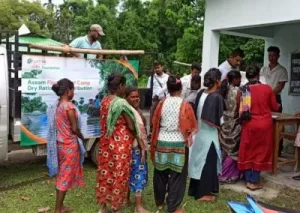- info@satyashaktifoundation.org
- Mon - Sat: 09.30 AM - 06:30 PM
Assam Flood Relief Camps
admin
10 November 2022
No Comments
Assam Flood Relief Camps

Heavy floods caused widespread destruction in Assam, affecting 457 villages in 12 districts, including Barpeta, Chirang, Darrang, Goalpara, Golaghat, and Dhemaji. The State Disaster Management Authority said that the flooding affected nearly twenty-five revenue circles.
Update on the flood’s aftermath
Fourteen shelters and camps across the state were opened to people needing assistance. There were about 700 persons taking refuge in these camps; 314 are in Chirang, 125 in Dhemaji, 162 in Golaghat, and 117 in Nagaon. As reported by the relevant authorities, many individuals died in Morigaon. New information from the state’s disaster management agency showed that 29,857 individuals in the Golaghat district were affected by the flood, whereas only 185 persons in the Nagaon district were affected. In contrast to the 10,536 persons impacted by the flooding in Morigaon, 15,981 acres of farmland were lost.
Earlier events in the Assam floods
Assam’s greatest fears have come true after days of heavy rainfall left multiple regions underwater. The Brahmaputra and its tributaries experienced flooding due to heavy rain. The exact same thing occurred to thousands upon thousands of individuals. The update from the Assam State Disaster Management Authority (ASDMA) indicates that the flood situation in Assam gradually improved. Rescue efforts went on, but Golaghat, Darrang, and Morgan districts remained the most brutal hit. In the days to come, they anticipated development. Damage to roads, bridges, and buildings, as well as agricultural loss, have all resulted from flooding. Many relief camps were set up across the state to offer inhabitants food and water. River levels remained high enough to warrant taking extra safety measures.
Assam has established relief camps to aid flood victims.
The relief camps were set up across Assam to aid those impacted by the flooding. They had asked all Deputy Commissioners to provide rescue and relief operations everywhere,” said Kumar Sanjay Krishna, Assam’s Additional Chief Secretary of Revenue and Disaster Management. Refugee camps were set up. They delivered tarps, water pouches, and the equivalent of 4,476.74 quintals of rice, dal, salt, and mustard oil. The Assam State Disaster Management Authority reported that 234 relief camps and distribution facilities around the state were housing 20,047 persons.
To prepare for Covid-19, Assam has released updated regulations for flood relief sites.
Because of the unexpected coronavirus disease (Covid-19) outbreak, the Assam State Disaster Operation Authority (ASDMA) released a new set of instructions for managing flood relief camps in the state this year. Many of Assam’s 33 districts experience flooding every monsoon, forcing hundreds of thousands of people to seek refuge elsewhere. Usually, most evacuees stay in temporary relief camps or schools for weeks until the floodwaters recede. Earlier, Pankaj Chakrabarty, the state project coordinator for ASDMA, said that “this year, the struggle to support those who might get affected due to annual flood menace would be considerably tougher due to the current Covid-19 pandemic across the globe, which also afflicted their state.”
The new regulations required district officials to allocate space for social distance standards by identifying different relief camps based on the population density of villages. Previously, each resident in a relief camp was allotted 3.5 square meters of area. This year, however, the relief camp’s permitted space was quadrupled to maintain the required one-meter social separation between convicts. The relief camps were declared no-spitting and no-tobacco zones and all necessary precautions were taken, including the distribution of face masks and hand sanitizers.
Assam has released updated regulations for flood relief sites.
The instructions stated that “medical teams were to be provided with personal protective equipment (PPE) units for conducting special screening throughout the registration procedure, and they will monitor the convicts’ health daily (instead of weekly).” “Immediate medical supervision was to be made if an offender sneezes and shows signs of the common cold. Covid-19 requirements stated that the patient was to be isolated. Precautionary precautions were to be followed while delivering humanitarian goods and preparation of meals. Thus, district authorities were urged to draught standard operating procedures (SOPs) for this.
The district administration “identified quarantine isolation facilities at higher altitudes for transfer of Covid-19 suspicious cases,” the instructions state. The district authorities were given the task of locating suitable highland locations, such as tea gardens with grasses “for the arrangement of the green fodder for livestock of the farmers/camp inmates,” to facilitate efficient livestock management. In Assam, 268 patients were reported to have been affected by COVID-19 symptoms of which 42 patients immediately recovered.
Tags : Assam Flood Relief Camps
Recent Comments
No comments to show.
Subscribe
Subscribe to our newsletter for the latest update.
Contact Us
- DPT 004, Ground Floor, DLF Prime Towers, Block- F, Okhla Phase-1, New Delhi- 110020 India
- +91-011 408 45450
- info@satyashaktifoundation.org
- Mon - Sat: 09.30 AM - 06:30 PM
-
© Copyright 2023 SATYA Shakti Foundation, All Rights Reserved. Developed By Kitoinfocom Pvt Ltd



Leave a Reply